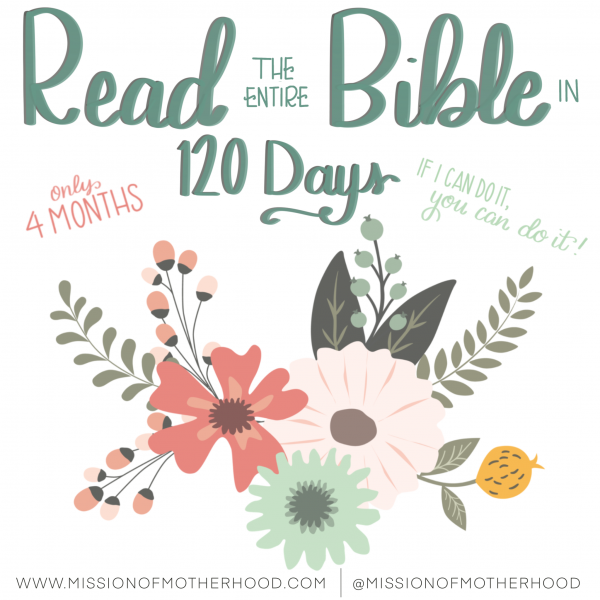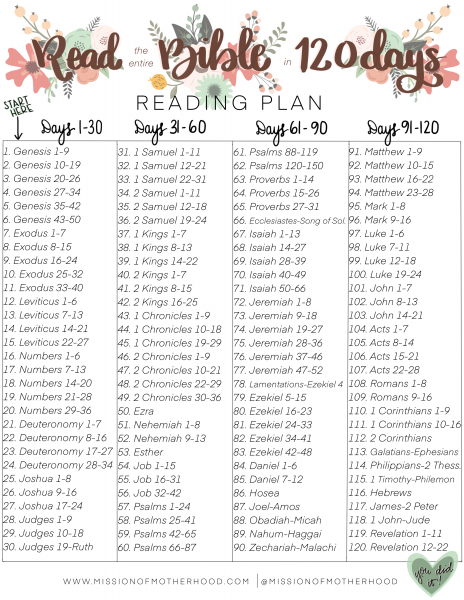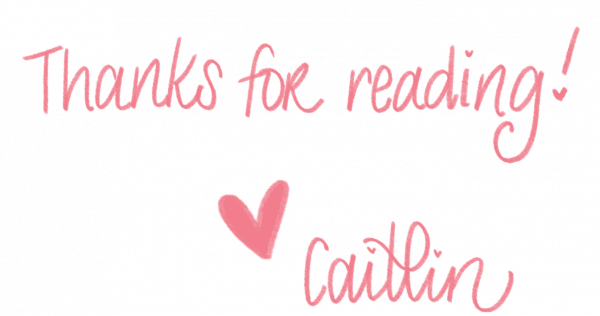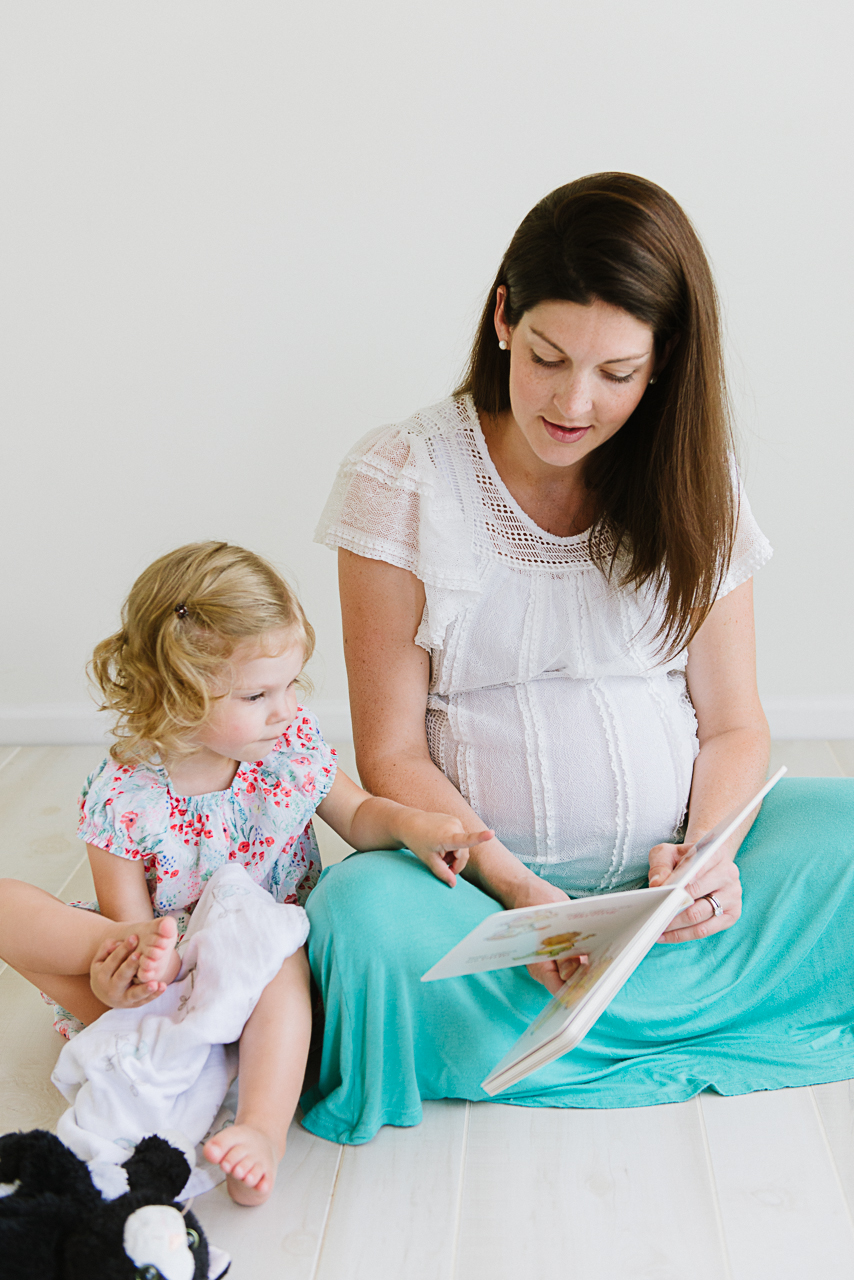That’s only 4 months! If I can do it, you can do it!
120 days is only 4 months. It seems daunting to read the entire Bible in only 4 months (cover to cover!), but it can be done. I know, because I did it. Actually, I shouldn’t lie, I did it in 128 days (I fell off the wagon at Thanksgiving and Christmas because we had so much family stuff going on), but my point is it’s TOTALLY do-able.

This post contains an affiliate link to the Bible I used for this plan. You can view the full disclosures policy here.
I’ve been enjoying getting to know the Bible more and more over the last 16 years. Growing deeper in my faith and constantly pursuing a relationship has been both a challenge and a blessing, but God has been faithful the whole time. This past summer, however, I felt conflicted and convicted about a bunch of things happening in politics, social justice (or lack of) in my community, and the divisiveness of the world. I suddenly had the thought that, while I trust my pastor’s expertise, study, judgment, discernment, and knowledge, if I am to hold our leaders to a standard, I have to know what that standard is. I’m not saying it’s necessarily my job to call out each one of our leaders, but I do believe that preachers, teachers, pastors, and leaders are held to a higher standard because of their influence in both secular and religious circles. How can I know that what they are preaching aligns with, or against, what I believe to be true if I don’t know what my source of truth actually says about a particular issue?
That, among a few other things, took me down a path of finding a plan to actually read the Bible. Historically, my Bible studies have been with books, videos, book studies, topical studies, passage breakdowns, books about the Bible, or some other form of someone leading me in what to read and how to interpret it. Not altogether bad, per se, but for the most part taking what someone else says the Bible says without always finding out for myself firsthand. (I’m reading Jen Wilkin’s “Women of the Word” right now, and she talks a lot about how these methods of study can be unhelpful. I’m guilty of that, as well as reading the Bible for what it has to offer me, instead of what it says about God). I decided that needed to change, so I looked for a plan that was just Bible reading. If you’ve ever searched for something like this, then you probably realized, like I did, that there are a LOT of plans out there.
Then, a good friend mentioned she completed a cover-to-cover Bible reading in 4 months while she was recovering from a terribly broken ankle. She mentioned she is one of the least disciplined people (I certainly would not have categorized her this way, but aren’t we always our own worst critics?), she said if she could stick with it, then so could I.
That encouragement was the push I needed. I chatted up my bestie and invited her along for the journey, dragged in the ladies from my small group for more encouragement, accountability, and moral support. On September 9, 2019, we dove in.

In The Beginning…
I’d started “read your Bible in a year” plans before and never completed them — they were boring and took too long and I couldn’t keep track of any . larger story when most of the plans had a little Old Testament, a little New Testament, and a Psalm. The 4-month reading plan I originally found online (thank you, Google) began in Matthew, the first book of the New Testament. So, the first 30 days were New Testament. However, one of the goals I had was to see for myself how Jesus in the New Testament is the fulfillment of the Old Testament, so I wanted to get the OT under my belt. Plus as a modern evangelical, I feel like (at the risk of sounding prideful here) I’m familiar with the New Testament. So, I modified the plan and began, literally, “in the beginning” with Genesis 1:1.
Most days the average reading was about 10 chapters, give or take a few based on their length (I’ve linked to the plan I used below, no worries!) The majority of the time, each day’s reading took me no longer than half an hour (30 mins! You can do anything for 30 mins!)
No Homework, & No Extra Reading!
The thing I loved from the beginning of this plan was that there was no study. Not that we shouldn’t be good students, but the point this time was just reading it. Read it like a novel, or the classical literature that it is, as a way to consume the information. God could have chosen anything as the Author of the universe to reveal Himself to us, and He chose the written word. Why not treat it as a text to be read and enjoyed, as well as revered and studied? I realized I couldn’t respect it as such if I didn’t know what was inside.
I bought this reader’s Bible because I wanted something big enough to sit and read for a long time, but with just the text in it (it has some margins to take notes), but no maps, footnotes, cross references, study notes, or life application to distract me. This obviously isn’t required, so feel free to use what you have on hand–a Bible app or website is just fine (in fact, when I do this plan again, I’m definitely using a Bible with maps and a timeline)! I picked the NIV because most of my church stuff and other recent Bible studies have been in ESV (the ESV is a newer, more literal translation, but for this purpose I wanted the easy readability in a major/widely accepted translation–but again, use what you have).
I liked the idea of literally reading it like any other book, cover to cover, to make notes and underline as needed, without being thrown off by previous notes and highlights, or losing my place for other studies. I won’t lie, either: a new book is exciting and I liked the novelty and newness of it as an added motivator. Something I didn’t foresee was the absolute satisfaction of seeing the ribbon bookmark move its way through that thick book! Oooh, how wonderful it was to see visual progress like that! It encouraged me to see that kind of progress so I could keep going!
I’m feeling insecure here (which is a form of pride, and if you know me in any capacity, you already know this is a thing for me): I do regularly read the Bible, I appreciate it’s messaging and it’s revelation and it’s value in teaching, reproach, instruction, and more in my every day life. But until this fall, I’d just never read it cover to cover. I don’t know why clarifying that even matters here, but there you have it. Again, I’m not trying to sound like I’m gloating at this accomplishment, either: I just want other people to be able to do this, to see that it is attainable and valuable!

What I Learned (& What’s Next!)
I found I was not successful if I waited until the very end of the night to do it, especially in some of the wisdom and prophetic books of the Old Testament, because it required a lot more mental focus than I had left at that point in the day. I did much better when I set aside some time in the middle of the day or earlier in the evening (maybe right after the kids are in bed while my husband cleans up dinner, instead of climbing into bed at the end of the night and thinking I could stay awake for the whole reading.
I’ll be honest, I was a little nervous for some of the Old Testament, because in previous “Read the Bible” reading plans, particularly the longer term ones, I’d get off track at the end of Exodus or Leviticus. It seemed like the Law took forever, I couldn’t keep track if I only read a chapter a day, and it all seemed so unnecessarily redundant. In this plan, shockingly, I didn’t find Leviticus to be that challenging: It only took me 3-4 days, so it felt pretty quick, and way easier to keep track of. I found the hardest books for me were actually in the wisdom books: Jeremiah, Isaiah, some sections of Psalms. I touch on this again below, but the reason I found them to be challenging was because I needed a better timeline to help me keep track of the larger plot.
The Bible is a book about God. I said before that I the reason I got off track or couldn’t stick with plans, etc, was because I was always reading them for what the Bible had to offer me. But the reality is, it’s not about me, and Leviticus (among others) definitely confirmed that for me!
Staying on track. I found it helpful to stick to an average of 10 chapters a day, even when the plan (linked above) only had 7-9. That way, it became easy to track without a printout, but more importantly, it built in a buffer for the times when I would inevitably get off track. We traveled out of town for a week at Thanksgiving, which was when my plan was scheduled to go through Jeremiah, and that was a real struggle with all the other stuff going on. I was only able to read a few chapters each of those days, but the buffer helped me not get too far behind my friend. Similarly, I prep for my Thursday morning weekly Bible studies on Wednesday nights after my small group meets, so I usually have less time on Wednesdays to read. The extra chapter or two on other days helped it all even out in the end.
If you find you do get off track, don’t be discouraged. You can still read the Bible at any pace. Accountability does help, but depending on how many people are in your group, you may feel tempted to stop altogether, or read 37 chapters to catch up. Don’t! Just pick up where the rest of the group is, and keep going! You can always go back at the end and read what you missed. Don’t be discouraged!
Know your learning style. I loved the reader’s Bible I linked to above, because I know I get distracted by footnotes and study notes and the like. I spend more time than I should wondering “what’s in this for me, where’s the life application?” However, knowing what I know now (which is still not very much about OT history and culture), I do wish I’d had a chronological timeline for keeping track of the prophets within the larger story, and a map. It was very hard for me to visualize the kingdoms and where stories were taking place without a guide. If you know these things will help you, by all means have them on hand (or find them online) so you can make the reading even more meaningful.
As I mentioned a few times, the biggest takeaway for me is that the Bible is a book about God. There is a lot of relevance for me, and a ton of life application, but there is also a lot more that is not about me. Knowing who God is, what He has promised, and who Jesus is (in every book of the Bible!) is really powerful. Reading each book in rapid succession like this made my understanding the whole Bible as one big story much more attainable, palatable, and exciting. It makes me want to do it again soon — maybe this time in chronological order, or maybe following the same plan above.
If you start this plan, let me know! Check back in when you finish and let me know in the comments what you thought. Let me know what other plans you’ve tried too; the Bible is living and active and we’ll never know everything, so we have to keep reading and studying!
Good luck — you can do it!



Thank you for all of your posts. Please keep up the fantastic work.
Hello! Just printed this plan and will start tonight! I will also be back after 120 days! 🙂
I’m starting today 27th June 2023. I’ll be back after 120 days to share my experience.
Hello, I am really interested in doing this plan. Can I find it in the YouVersion app as well?
Thanks Caitlin for this write up. I have tried many plans in the past but didn’t get to the end of it. I’m encouraged to try again by this plan.
Hi, I would LOVE this resource in Spanish. Is there any way you could upload a version like that for my Ladies Sunday school class to follow? My husband and I are missionaries in Nicaragua. I love the look of your plan – simple is GREAT! Thank the Lord, I’ve just finished reading my Treasure (Bible) for the 15th time, and I’m curious at different approaches.
Thank you!
I’m rusty with my Spanish as it isn’t my first language—are you asking for just the plan with the books of the Bible in Spanish? Feel free to send me an email and we can definitely discuss it some more.
This is exactly what I have been looking for! I never read the bible in full before I was looking for a fast plan for a first read and God directed me to this site! Bless!
im 15 now! and this is my very first step i took towards reading bible and i got this hope ill complete it ! ill update when i finish thankyou for this !
Thank you so much for this encouragement!! I found your blog about 7 days into my decision to read 10 chapters a day and read the whole Bible in 4 months. I’m so grateful to know others are doing it. I’m keeping a note book of my observations and questions. 😊
That is excellent! I hope you enjoyed it—-even if you get off track, it’s still a good exercise. Let me know what you thought when you finish!
Hi Caitlin, I loved your article! I decided I was going to read the Bible in 4 months after hearing a youtube sermon from a Pastor here in Brazil. I wanted to finish it by the end of April. Unluckily I started only after the 10th January reading 10 chapters a day as I figured that would do it.
I just past through the Pentateuch and as you said, I found Leviticus, Numbers and Deuteronomy to be so much more fun and meaningful than ever before!
Thanks for the hints about having a timeline and maps for the prophetic books, I will surely be providing for myself.
I do read at a bit slower pace as for me it takes about an hour to get thru the 10 chaps, but it is a very exiting journey! I am lovin’ it!
Ok big hug my sister in Christ, here from Brazil!
Thanks for Reading plan God Bless You
I want to start the 120 days Bible reading plan today. I wish I can get a group to go together so we serve as check for one another.
My friend and I did it together from two different states, it can definitely be done! We keep in touch regularly but depending on your situation you could do a virtual meeting. Another friend of mine has a Facebook group for her read through, so if nothing else you could join there and read with them: https://www.facebook.com/groups/459517518051354/about
You will probably find this hard to believe, but I have read through the Bible 150 plus time over the past 50 years. I have been able to keep track of all the times by journaling what I have read. Each time I open the Bible, I see something new. It never gets old.
Wow! This is amazing. Thank you for blessing us with your comment. It’s so beautiful to hear that you find something new every time. My goal is to read the bible at least 2 to 3 times a year. I am currently in the New Testament. I started off good reading in July and got off track when I started to get into Isaiah, Jeremiah, etc. But I got back on track and I am behind but want to try to finish the rest of the New Testament before the year ends. I want to start the year reading it again. I have learned so much and I am so excited to read everything again.
That is so incredible! 150 times you read through the Bible. How many times a year did you read through the Bible? Very excited to hear!
I’m starting today by Gods grace.
Thank you for the love and encouragement sister in Christ.
I started to read the entire Bible every year since 1991. I’ve read it through 31 times since and it’s such a wonderful and hard to describe experience. Hundreds of times i read on a specific day exactly what I needed for that day and time of my life. (I have a journal of that). I’m still doing it but I might try your 120 day program. PRAISE GOD FOR HIS PRECIOUS BOOK!!!
i need it for accountability too